
Return to Marlborough Forest (part 1)
July 31st, 2016
I couldn't stay away. This time I spent the afternoon there, and managed to shoot some crowd-pleaser insects (i.e. butterflies) and forest miscellanea in addition to the usual creepy crawlies.
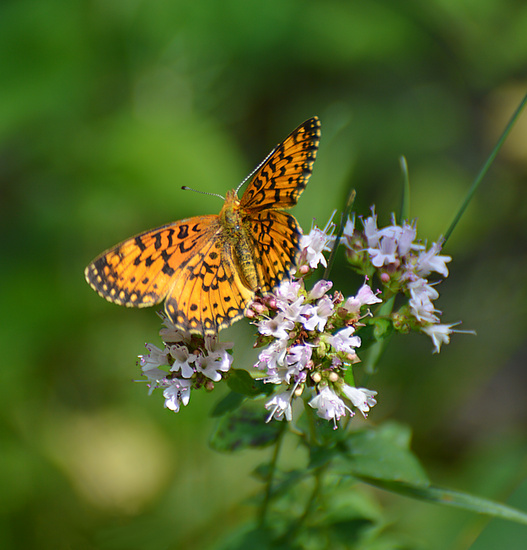
Silver-Bordered Fritillary, wallpaper available

This Ovenbird got ruffled, literally and figuratively, when I hiked through its territory, giving me a rare good view as it hopped out into the open to investigate the disturbance. Ovenbirds are elusive deep-woods warblers. They are actually common, but you hear their loud, rhythmic crescendo of a song far more often than you see them. They frequently erect the orange stripe on their crown when startled.
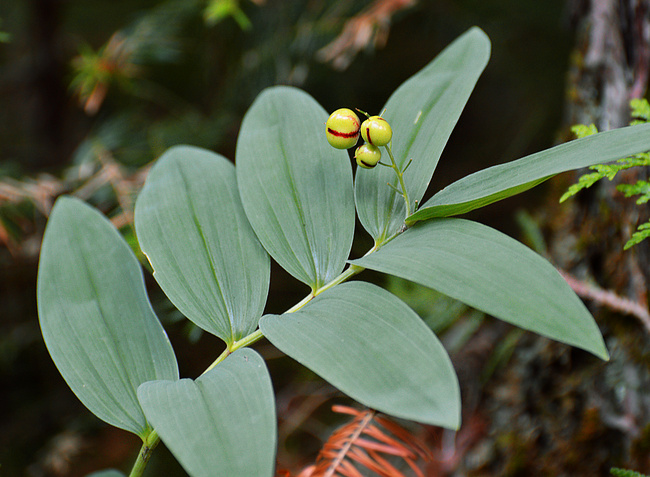
Strange berries on the forest floor. This is False Solomon's Seal, I think.

Great Spangled Fritillary, wallpaper available

Acadian Hairstreak. I almost overlooked this beauty; it appeared very small and plain until I trained the zoom lens on it. Thanks to Gillian Mastromatteo for the ID help!
Two Beauties
July 25th, 2016
A couple from Carp Ridge.
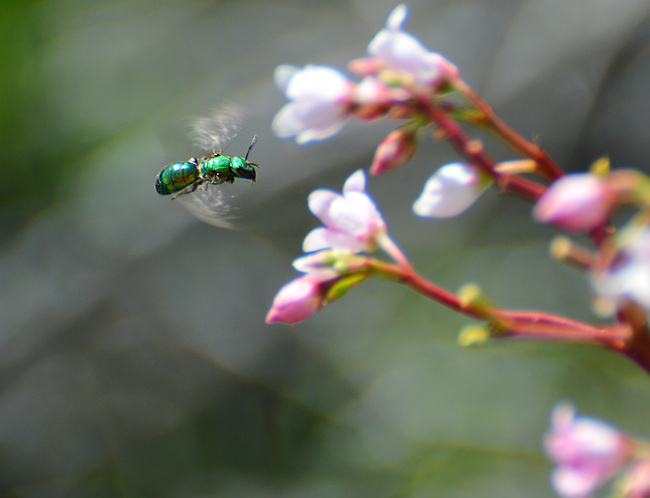
1680x1050 wallpaper
A Sweat Bee at Spreading Dogbane. Sweat bees (so named because they occasionally land on people to drink sweat) are not as well known as their larger relatives, honeybees and bumblebees, but they are important pollinators.

Common Yellowthroats nest in wet areas with dense undergrowth. They are skulky by nature, but the skulkiness is in a tug-of-war with curiosity. When a large mammal bumbles into their territory, they sometimes can't resist popping out into the open for a moment to have a look at you. It's then only a matter of firing the shutter fast enough! This one was at the edge of one of Carp Ridge's many beaver ponds.
Insect Safari At Cedar Grove
July 21st, 2016
Oh, Marlborough Forest. You are a pestilential place, but I love you.
On the evening of the 13th I went to Cedar Grove Nature Trail in North Gower, a sunset walk with camera in hand. I knew I was in the right place when eager deer flies swarmed my car. The first one bit me within 30 seconds of emerging, at which point I slathered myself with a thick layer of DEET like I should have done in the first place. I could hear them constantly buzzing around me everywhere I went, with the occasional louder zoom as a dragonfly whizzed by and picked one of them off.
There were a few more deer fly bites over the course of the evening. But that's nothing compared to what got my legs. I still don't know what it was, maybe wasps. Shortly after I stepped into a tall wildflower field something went up both pants legs and went to town on me. It didn't really hurt at the time, I assumed it was more deer flies. But by the next morning, I was swollen from my ankles almost to my knees and it hurt to stand.
For this somewhat steep entrance fee, I enjoyed the most gloriously insect-rich woodland in all of Ottawa/Gatineau. I don't know what it is about Marlborough Forest. I mean, there are insects you see everywhere. Everywhere has butterflies, everywhere has dragonflies, everywhere has mosquitos. This is not that. This is tiny weird red wasps, tiny weird blue wasps, micro moths, goldenrod crab spiders, mystery crab spiders, mystery bees, insects I don't even know how to categorize, and all of these in such numbers that it's as if the place is bursting at the seams with them. Often they crowd two or three to one flower. Maybe it's just the sheer size of the conservation area that allows it to be so rich and wild. Maybe it's the relative remoteness from urban development. I imagine that this is what the world must have been like before humans--before we razed the wilderness and sprayed insecticides all over it. This is what paradise must look like.
...well, except for the deer flies. And the wasps. And the fact that a significant fraction of those insects are looking to eat and/or parasitize the remainder. This is what paradise must look like to an entomologist, I mean.
Most of them, certainly the ones that fascinated me, were tiny insects. They made me ache for a good macro lens. I struggled to get these little beauties in focus and all of them required extensive digital sharpening. For whatever reason, just like the last time I shot insects at Cedar Grove, they were almost all on Black-Eyed Susans. They hunted atop Black-Eyed Susans, laid eggs on Black-Eyed Susans, munched on Black-Eyed Susans...
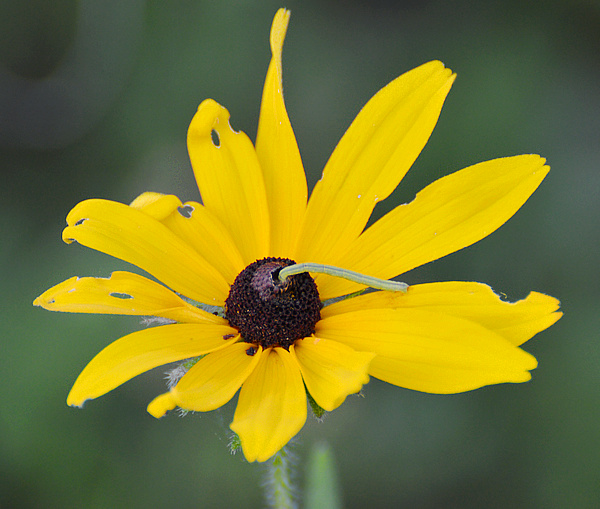
Small green inchworm-type caterpillars seemed to be everywhere I looked. Practically every other Black-Eyed Susan blossom had one on it. They were often sprawled at strange angles so as to look more like a fallen bit of plant litter than a creature, which likely helped fool predators. But I'm sure some of the predators noticed, as I did, that the little green sticks were awfully hungry.
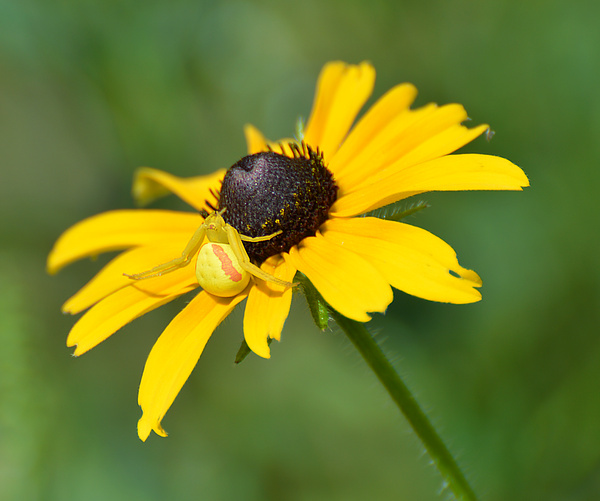
A Goldenrod Crab Spider. I find them strangely beautiful. I seldom spot them anywhere else, but at Cedar Grove Nature Trail, it's impossible to get away from them. They perch on flowers and wait for prey to stumble by, with their four front legs spread wide poised to grab.
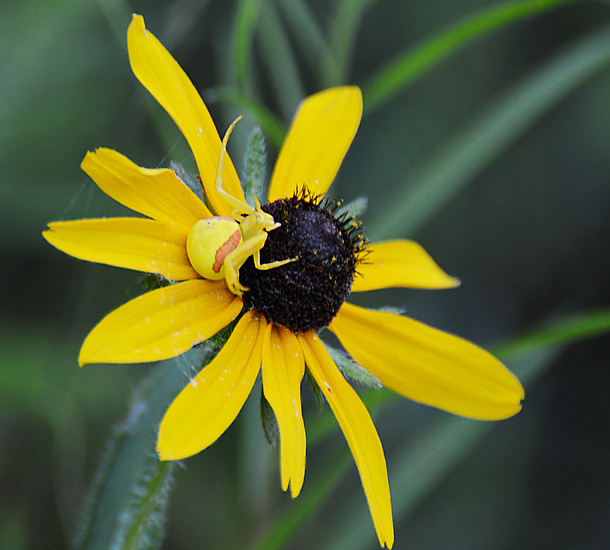
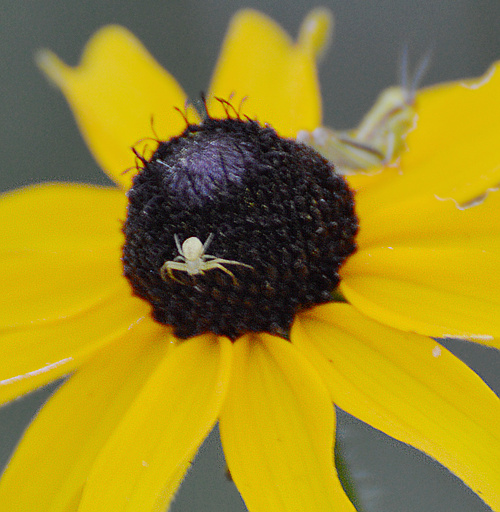
Eensy-weensy baby crab spider. That's a grasshopper behind it on the same flower. Regrettably, it was impossible to get both in focus.
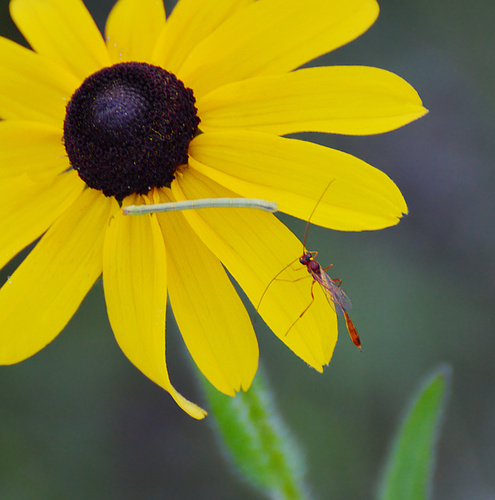
1680x1050 wallpaper
This spindly red thing is a parasitoid ichneumon wasp, and it may have designs on that caterpillar.
Even an expert entomologist probably could not tell me which ichneumon wasp. There are thousands of known species in North America and probably thousands more undescribed. (This fact makes me want to go back to university, study entomology and do my thesis at Cedar Grove trail. Except then someone else would have to do a thesis on me, entitled "How A Woman Was Literally Driven Insane By Deer Flies.") If you are an insect and there are a lot of your kind, nature has probably evolved a parasitoid wasp just for you--that is, a wasp who will give you to its young as food. Some, like the aptly named Tarantula Hawk, paralyze their victim, drag it into a nest burrow, and lay their eggs on it. Others pierce it with a stinger-like ovipositor and lay their eggs inside, in which case it doesn't notice a thing until the eggs hatch, and the larvae start eating it from the inside out.
Many thanks to the folks at What's That Bug for their help with this one!
( Click for more )
Sweet Pea
July 17th, 2016
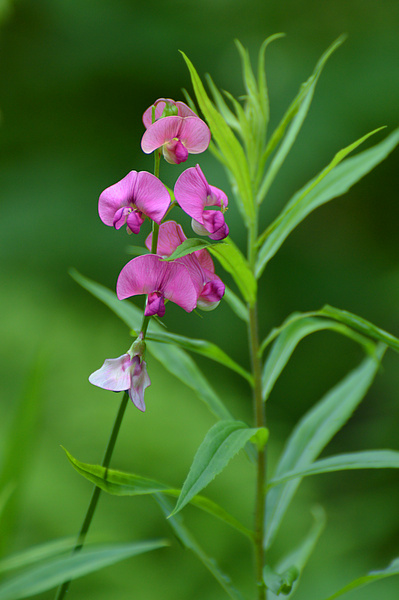
Breeding Warblers In Cottage Country
July 13th, 2016
I spent much of Canada Day weekend with friends at a lakeside cottage in Denholm, Quebec (north of the Gatineau.) The social time was wonderful, but, being me, I took it in small doses amidst ample doses of alone-in-nature time! There were loon yodels and thrush melodies (Veery, Swainson's and Hermit Thrushes all breed there), and warblers to chase after with my camera. As usual many of the warblers eluded me, but not all.
You can always tell a place that birders seldom visit. The pish responses are terrific! A "pish" is a sound you make to imitate scolding songbirds, intended to draw real songbirds out into the open to see what the fuss is about. In places where a lot of birders tromp around pishing, the birds' reaction to it is frequently tantamount to "yeah, whatever." Not so in those cottage woods.
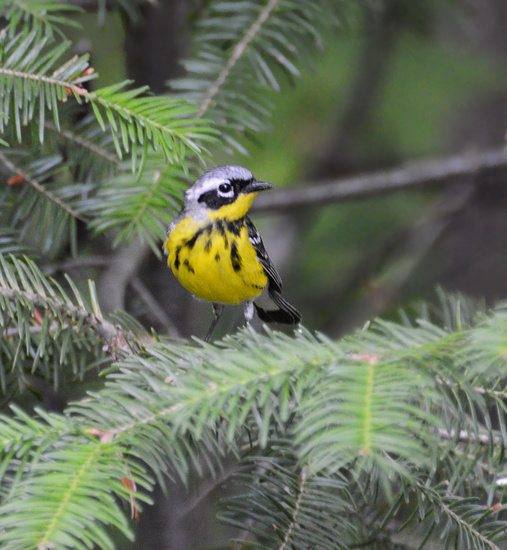
A beautiful male Magnolia Warbler, one of the successful pish-ees. Magnolia Warblers prefer dense, pure stands of spruce and fir for nesting (their name is a misnomer), and so are a rare sight in Ottawa in the breeding season. But you don't have to drive very far to get to places where they are a common sight.
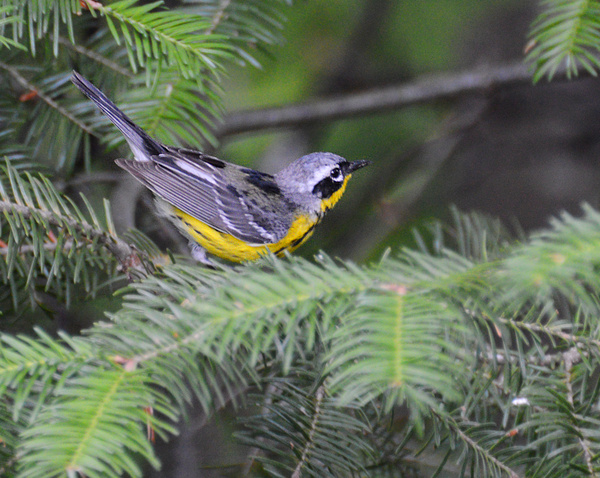
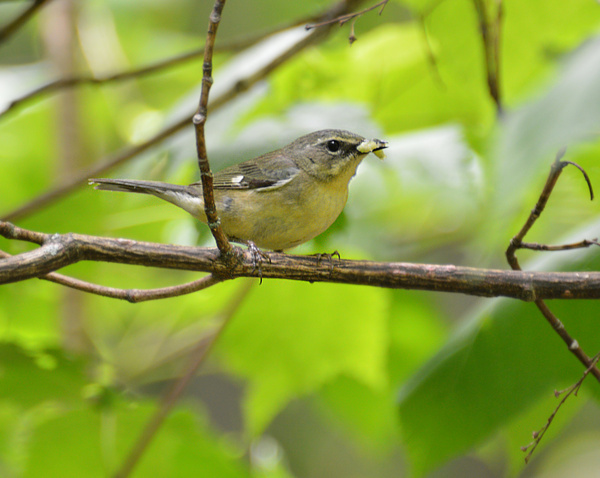
I found this lady during a hike in the pristine forest across the lake. The unique face pattern plus that whitish spot on the side mark her as a Black-Throated Blue Warbler. I did glimpse her more colorful mate, but he eluded my camera! As usual, I was in the middle of climbing up a steep slope when I first heard him singing. Black-Throated Blues love hilly terrain and can be found nesting in Gatineau Park, along Wolf Trail for instance.
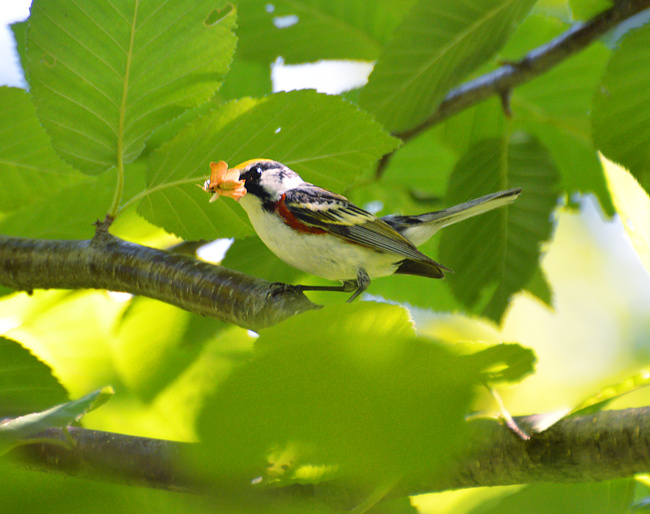
Another bird carrying a meal for its young, this time a male Chestnut-Sided Warbler. The meal appears to be a moth or a skipper (mothlike butterfly) of some sort.

Male Yellow-Rumped Warbler.
Montreal Biodome 2016 (part 3)
July 8th, 2016
My final Biodome pix are from the lynx enclosure. I'd been to the Biodome maybe three (four?) times before this, but never caught more than a glimpse of the lynx. This time it was out in the open.
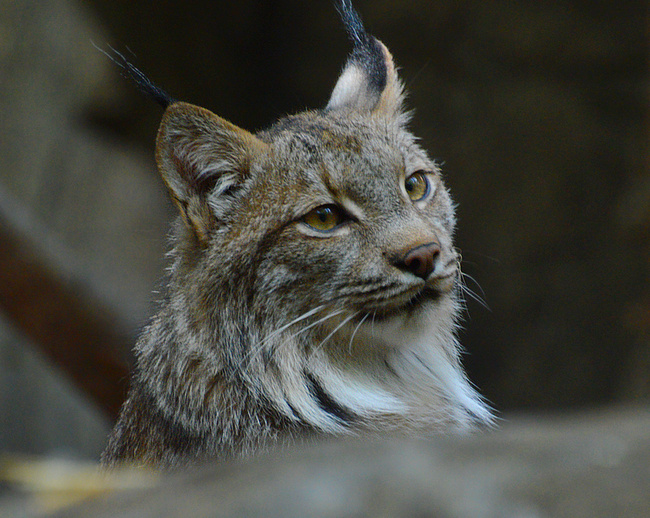
Two birds were flitting around in the trees at the top of the enclosure, a cardinal and, I think, a Black-and-White Warbler. (Were they able to fly into there from the main Laurentian Forest exhibit, or were they put in the enclosure specifically for enrichment? I don't know.) The lynx was very interested in them. It seemed very like an overgrown housecat as it stared up at them speculatively. It finally made a spectacular leap onto a tree trunk and then onto the rocks above. I think it's great that the lynx had something around to hunt, although the birds may not agree!

Montreal Biodome 2016 (part 2)
July 4th, 2016
The St. Lawrence marine ecosystem is always my favorite at the Biodome. It is not the only exhibit that puts no barrier between people and creatures, but of them all, it feels the most like being in the wild. Natural light streams in from above, kittiwakes and terns fly back and forth over your head. (People seem to worry about getting pooped on, but I've never seen it happen to anyone.) The ducks there are the kinds of ducks bird-watchers delight in--Harlequins, Eiders, Long-Taileds--and far closer in than we normally get to see them. I feel that I could just sit and soak in the ambience for hours, but my companions always insist on moving on eventually!
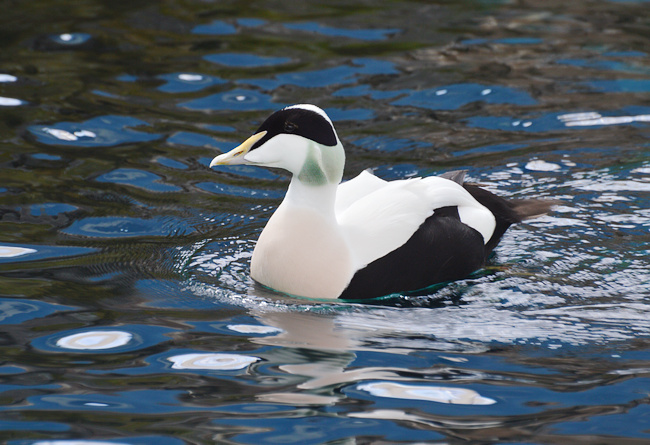
Male Common Eider. These handsome fellows are a common sight on the north Atlantic coast. (I lifelisted them in Gaspé, and saw more in Cape Breton last year.) They are also the source of eiderdown, the most expensive and effective down in the world. Since female eiders shed their own down to line their nests with, it can be harvested humanely by simply visiting the nests and gathering the down after the nesting season is over. This is still done today in Iceland.
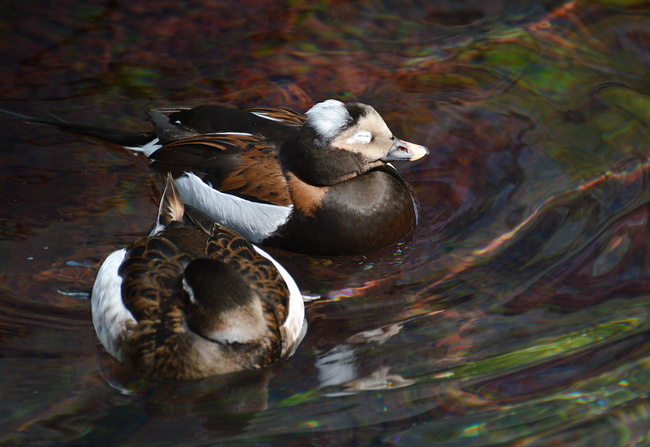
Long-Tailed Ducks having a nap. This species migrates through Ottawa, but I seldom see them, especially in their handsome breeding plumage.
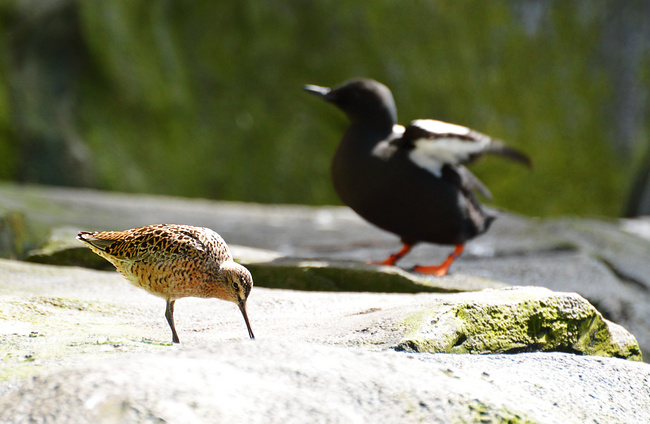
Amidst the obvious and charismatic birds of the Biodome, there are a number of others that are easily missed. I seem to see something new every time I go there. This was the first time I spotted a Dowitcher (in the foreground above), a type of sandpiper that, like many sandpipers, breeds in the Canadian far north. I didn't recognize it at first until I saw it probing the rocks with a "sewing machine" kind of motion. This is a giveaway for dowitchers mentioned in just about every field guide.
In the backdrop, a Black Guillemot with his trademark bright red feet.
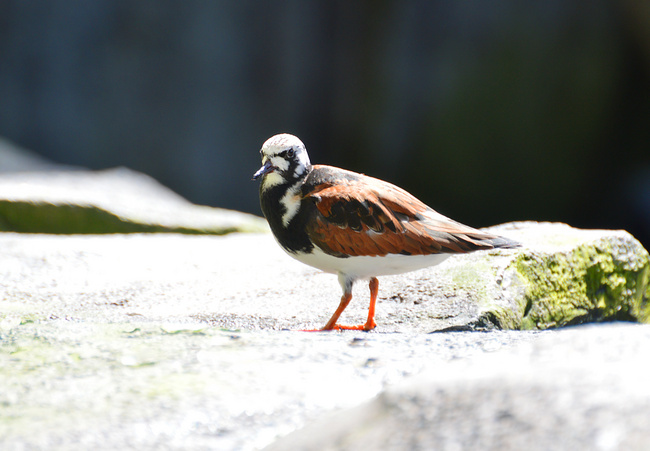
Ruddy Turnstone, an unusually colorful sandpiper. This species occurs wild in Ottawa (in migration), but has eluded me for nine years and counting. A captive bird, of course, cannot go on the lifelist!

Black-Legged Kittiwakes. Kittiwakes look similar to our familiar parking-lot-scavenging Ring-Billed Gulls, but are entirely different in their habits. They are strictly coastal, spend little time around humans, and nest in tiny crevices on sheer cliffs. Baby Kittiwakes have what one website calls "a very strong stay-put instinct." It's a long way down!
Continued in next post...
Montreal Biodome 2016 (part 1)
June 28th, 2016
On June 16th I went to the Montreal Biodome along with my mother (visiting from Virginia), my husband and his mother. I brought the camera and captured all that I could! This first set is from the tropical, South American exhibit.
You can see my previous photo shoot at the Biodome here, here, here, and here (four pages worth.) I tried to focus on different subjects this time, although I couldn't resist a second crack at the Hyacinth Macaws.
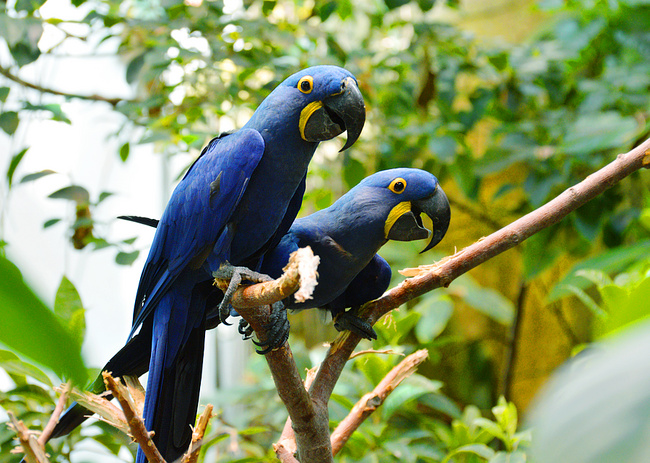
1680x1050 wallpaper
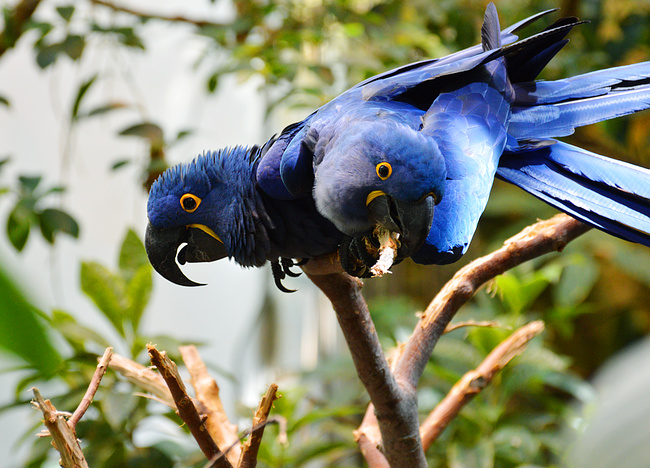
1680x1050 wallpaper
Sometimes it's hard to shake the impression that these birds are funning with me.

1680x1050 wallpaper
Golden Lion Tamarin--a highly endangered monkey, with only about 3200 left in the wild. We mammals are not usually known for our striking colors, but I think these tamarins rivalled for beauty the macaws and other tropical birds that surrounded them.
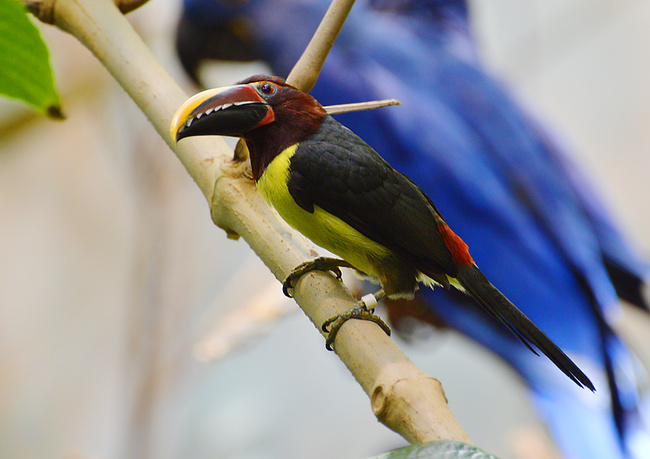
1680x1050 wallpaper
Green Aracari, a type of small toucan. (It is a close relative of the Fiery-Billed Aracari that Michael and I saw in the wild in Costa Rica.) That's a Hyacinth Macaw in the background, to give you an idea of scale.
( More (Scarlet Ibis, White Ibis) )
Breeding Birds In Frontenac Park
June 25th, 2016
I have figured out the cure for insomnia: go on a birding tour with Jon Ruddy.
No, I don't mean that Jon Ruddy's birding tours are boring, quite the opposite. I mean they are a workout and a half! At least this one was. Along with five other birders, we went to Frontenac Provincial Park, a 52 square kilometer protected wilderness north of Kingston, and birded the trails around Big Salmon Lake. It was May 23rd, but few spring migrants were present. Instead the woods teemed with local breeders, singing and nest-building and occasionally fighting with their neighbors.
Many birders' approach to hearing an interesting bird in the distance is to stand on the trail, pish, maybe play recordings of that bird's song, and hope that it will get curious and come within view. Jon's approach is more like this (paraphrasing):
"I hear a Scarlet Tanager over there! Lets go!" bushwhack bushwhack bushwhack CLIMB CLIMB CLIMB descend descend descend
"I hear a Cerulean Warbler back over there!" Lets go!" bushwhack bushwhack bushwhack ...
It helped that the woods were quite open, but there was much scrambling up and down rocky outcroppings. I liked this approach for a few reasons: it made for a terrific workout, it made for a much more interesting hike (I'm often a little bored by the "stand and wait" approach to bird-watching, and it's seldom how I do things when I bird alone), and it meant not confusing/upsetting birds with playback. That's something I've never been entirely comfortable with. I've always wondered: what if a male feels so threatened by this imaginary rival that he just up and leaves a perfectly good territory? Or what if a female wastes valuable time and energy trying to find the imaginary mate, lingering because of that tantalizing song, when she could move on and find a real mate elsewhere? I still remember the reaction I got from a brief playback on a Sora. It called incessantly ("ker-wee?") for the twenty minutes I sat there. When I came back through later, it was still in the same place, still calling incessantly. I felt bad for it.
No photos. For this trip, I just wanted to drink in the sights and sounds, instead of needing to capture them. (I will likely do this trip again next year, and possibly bring the camera then. I also plan to go back to Frontenac on my own sometime.)
Frontenac is stunningly beautiful--and underappreciated, judging by how many people we met on the trail on a holiday weekend. In some ways the park, at least the bit of it I saw, is very reminiscent of South March Conservation Forest. The rocky sunlit outcroppings, for instance, colored with generous sprays of Wild Columbine, with Rose-Breasted Grosbeaks singing on the margins. Climbing up onto those outcroppings I felt like I was back home again.
Down in the woods, I turned up a Dutchman's Breeches. Like the ones I saw in South March on the 15th, it had already lost its blossoms. Even the leaves were gone (wilted and vanished into the leaf litter, I guess), but I recognized the thin, pale green seed pods, arranged in a row along the drooping stem. As I handled the stem, some of them fell off. (Soon the pods will burst, revealing seeds with fleshy appendages called elaiosomes. Ants will carry the seeds back to their colonies, feed the elaiosomes to their larvae, and leave the seeds in a good place to germinate: a symbiotic relationship.)
In other ways it's not reminiscent of South March at all, as in the Cerulean Warblers that were singing all over the place. This little aqua-blue warbler is an endangered species in Canada, and Ottawa has maybe one or two known breeding pairs. Frontenac Park is their heartland. In general, Frontenac had a ruggedness and majesty about it that was unlike anything I'd experienced in Ottawa or Gatineau--one that rather reminded me of Algonquin Park (but much less boreal.)
Highlights:
A knee-buckling view of a blazing Scarlet Tanager, about fifteen feet away at eye level, completely out in the open, singing. I honestly didn't believe it was possible for a Scarlet Tanager to act like that. I thought "hide in the foliage fifty feet up taunting the bird-watchers" was pretty much their genetic programming. We never did a single playback and yet this thing happened.
Same spot: Cerulean Warblers whizzing back and forth practically in front of our faces. These are canopy birds, but the boulder we had climbed to get to the tanager more or less put us in the canopy!
Female Black-Throated Green Warbler and Rose-Breasted Grosbeak landing down on the rocks and foraging for nest material.
Close up views of a Yellow-Throated Vireo, a bird I'd only ever seen before at a great distance.
A Barred Owl, wide awake in the middle of the day, in plain view and calling back and forth with its distant mate.
"Whoooo whoooo?"
"Who cooks for you, who cooks for youuuu!"
(I can only gather that sightings like this are commonplace in Frontenac. A couple of backpackers came by and I asked them if they'd like to see an owl. An invitation like that in Ottawa or Gatineau would usually garner interest, even from people who aren't bird-watchers per se. They just waved their hands and moved on, saying that they'd seen all kinds of owls already.)
In the afternoon, after I had bolted down a heap of extra hot capicollo and SunChips within the allotted fifteen minutes, we went to Napanee Limestone Plain IBA (important bird area). This is a mosaic of grazed pastures, savannah-like grasslands and scrubby woodlots, all growing on a thin layer of soil over limestone bedrock--i.e., an alvar. Alvars are an increasingly rare habitat, supporting many declining, grassland-loving species. Napanee IBA is crucial breeding habitat for the endangered-in-Canada Loggerhead Shrike, one of North America's very few carnivorous songbirds, which would be a lifer for me.
Unfortunately my prospective lifer failed to show. (I'll be back!) So I contented myself to enjoy the Eastern Meadowlarks, Bobolinks and Upland Sandpipers, all of which we saw more of than you could shake a stick at.
And then I went home and slept like the dead.
The Showstopper
June 7th, 2016
On May 18th, I headed out to Mud Lake before sunrise, and rediscovered how incredible the trail can be when you're the first person to hit it! Early morning surprises included: A Great Egret fishing next to a muskrat lodge where a Canada Goose was sitting on eggs (surprisingly, the goose didn't seem to mind.) A raccoon about ten feet up a tree trunk, grabbing at the stump of a branch so he could lean out to peer curiously at me. The resident Eastern Screech-Owl in his hole with his eyes still wide open.
In the pine woods, a group of recently fledged teenage ravens was hopping from tree to tree and making an unholy racket as only teenage ravens can do. Then I was surprised to hear a strange sound that actually rivalled theirs for volume: a sort of rich cackling that resounded through the forest. At first I thought it was one of them playing with his voice, and even once I realized I was hearing a Wild Turkey gobbling, I thought it might actually be one of the ravens imitating a turkey. (I've caught a raven imitating a goose before, so it didn't seem too much of a stretch!)
But then I spotted him, a wild tom turkey, up in a tree by the water. After a good look and listen I walked on. When I came back through later, the sun was up, my camera was out, and he was on the trail putting on a show.
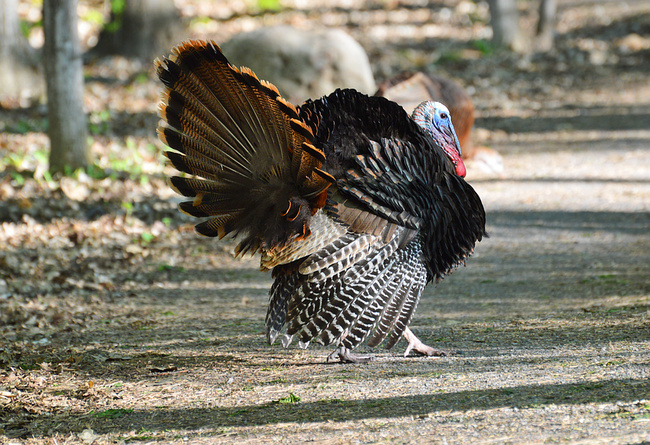
He was fearless. He strutted up and down the path, fanning his tail and ruffling his feathers. He made clear that he considered the trail his display court, and that while he didn't particularly object to me watching, if I happened to be standing in his way...well, one of us was going to have to either back up or go around, and it wasn't going to be him.
He actually seemed to gauge his tail-fans so that the morning sun caught them perfectly. Tail closed, he stepped into a shaft of sunlight, and suddenly...
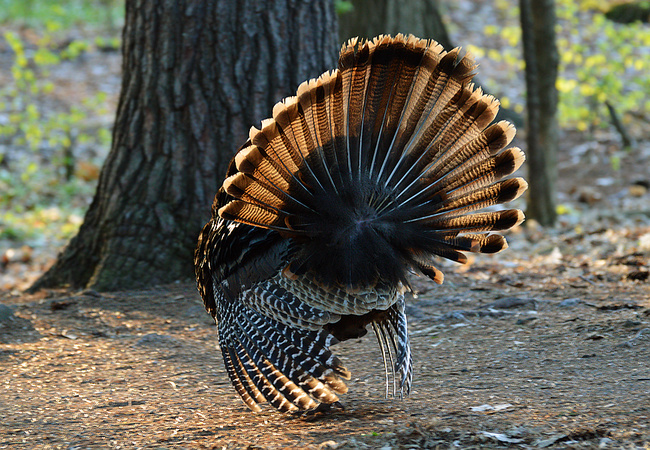
1680x1050 wallpaper
Pictured below with the female in front. This is not the first time a Wild Turkey has shown up at Mud Lake, but it is, as far as I know, the first time one has found a mate there.
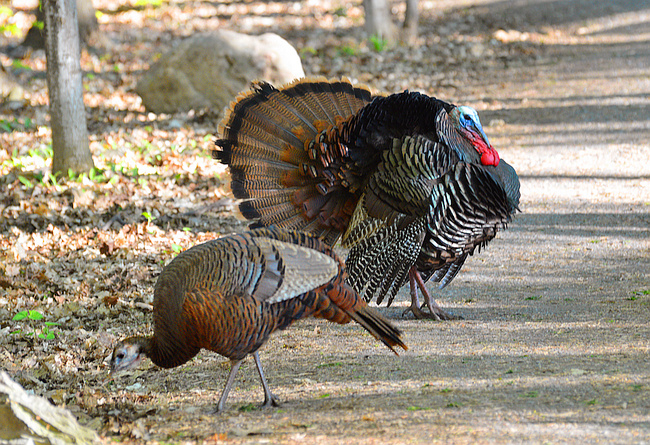
In other news, newborn goslings. It was a frigid morning; good thing they had their parents to keep them warm.
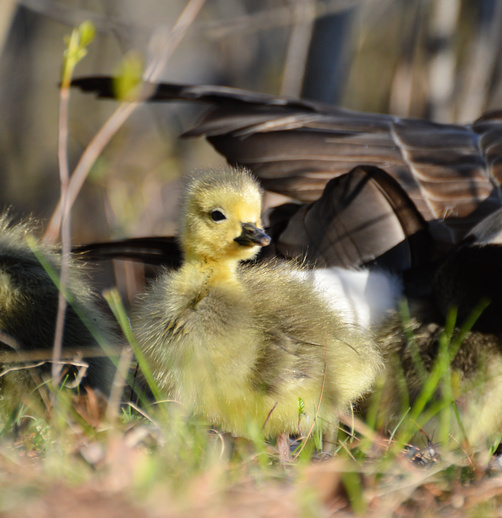
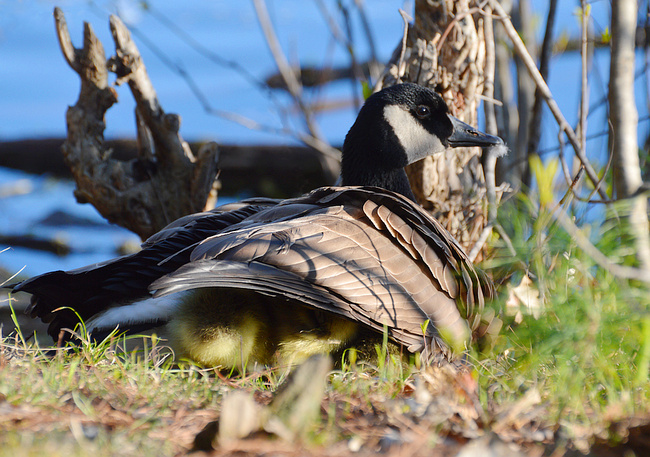
|
